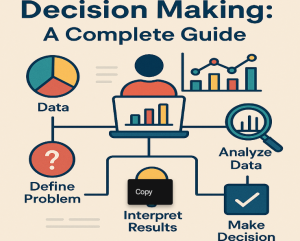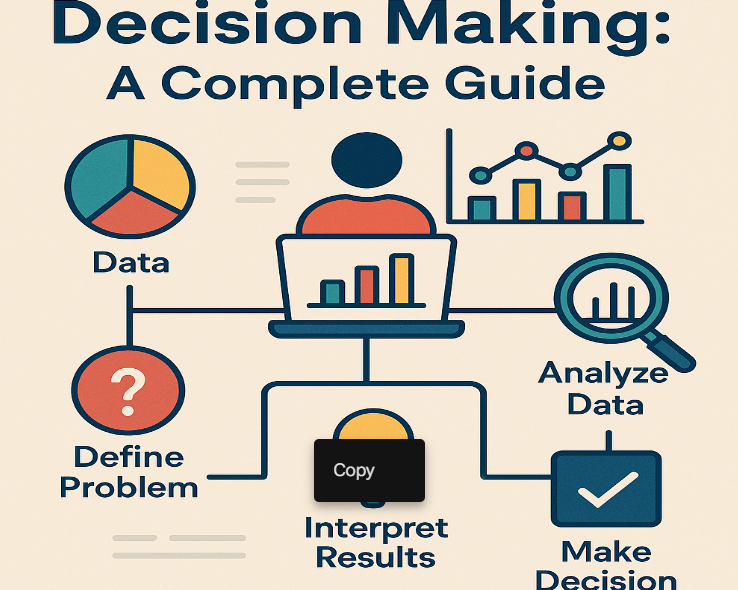In today’s fast-paced, digital-first world, organizations are surrounded by an overwhelming
amount of data. From customer interactions and operational metrics to market trends and
competitor activities, data is being generated at an unprecedented rate. However, the true power
of this data lies not in its volume but in how it is utilized. Businesses that can efficiently collect,
analyze, and act on their data are better equipped to make smarter decisions, identify new
opportunities, and remain competitive. This is the essence of data-driven decision making
(DDDM).
This guide explores the fundamental principles of data-driven decision making, its benefits, the
step-by-step process involved, the tools that support it, and the cultural transformation required
to fully embrace it. Whether you’re a business leader, analyst, or aspiring data scientist, this
resource will provide you with a strong foundation for adopting a data-centric approach to
decision making.

What Is Data-Driven Decision Making?
Data-driven decision making refers to the process of making business decisions based on actual
data rather than intuition, guesswork, or personal experience. It involves collecting relevant data,
analyzing it to uncover patterns and insights, and using those findings to guide strategic and
operational choices.
Rather than assuming what customers want or speculating about future market conditions, data-
driven organizations rely on evidence-based insights. This objective, analytical approach helps
ensure that decisions are more accurate, efficient, and aligned with the organization’s goals.
Why Data-Driven Decision Making Matters
Adopting a data-driven mindset offers a wide range of benefits, many of which directly
contribute to improved organizational performance and competitive advantage. Here's a
breakdown of the key advantages:
1. Enhanced Decision Accuracy: Using reliable data reduces the risk of decisions being
influenced by personal bias, flawed assumptions, or anecdotal evidence. Instead, it provides a
clear, factual basis for making choices that are more likely to yield successful outcomes.
2. Increased Efficiency and Productivity: Data can highlight inefficiencies in workflows,
bottlenecks in operations, and areas of waste. By addressing these issues, businesses can
streamline processes and improve productivity across departments.
3. Better Customer Insights: Through analytics, companies can better understand customer
behavior, preferences, and buying patterns. This enables more personalized marketing, improved
customer service, and the development of products that better meet customer needs.
4. Greater Profitability: By identifying high-performing strategies and eliminating
underperforming ones, organizations can allocate resources more effectively. Optimizing pricing,
targeting high-value customers, and reducing churn all contribute to increased profitability.
5. Improved Marketing Performance: Analytics tools provide real-time visibility into
marketing campaign performance. Organizations can test different tactics, measure ROI, and
continuously improve campaign outcomes using data insights.
6. Stronger Competitive Advantage: In a marketplace where rapid change is the norm, data-
driven businesses are more agile. They can respond quickly to shifts in demand, anticipate
market trends, and innovate faster than their competitors.
7. Effective Problem Solving: When challenges arise, data helps uncover the root causes and
evaluate potential solutions. This structured approach to problem-solving results in better long-
term resolutions and informed decision-making.
The Data-Driven Decision Making Process
Transitioning to a data-driven approach requires more than just tools—it requires a disciplined
process. Here is a step-by-step framework that organizations can follow to implement DDDM
effectively:
Step 1: Define the Problem or Opportunity: Start with a clear and specific goal. What
question are you trying to answer? What outcome do you want to achieve? For example:
“Why are we experiencing a drop in customer retention?”
“Which ad campaign generated the highest return on investment?”
Step 2: Identify the Right Data Sources: Next, determine where the necessary data can be
found. This could include:
Internal sources: CRM data, sales records, customer service logs, website analytics, etc.
External sources: Market research, industry reports, social media, competitor analysis.
Step 3: Collect and Clean the Data: Gather the data and ensure it is:
Accurate
Complete
Consistent Data cleaning is crucial to avoid misleading results. This may involve
removing duplicates, correcting errors, and standardizing data formats.
Step 4: Analyze the Data: Use statistical and analytical methods to extract insights. Techniques
can range from basic descriptive statistics to advanced machine learning, depending on the
complexity of the problem.
Step 5: Interpret the Insights: Translate the analysis into actionable insights. Ask:
What trends or patterns stand out?
Are there any surprising results?
What conclusions can be drawn to support a decision?
Step 6: Make Informed Decisions: Use the insights to select the most appropriate course of
action. This step should involve collaboration among decision-makers and a careful evaluation of
trade-offs.
Step 7: Implement the Solution: Roll out your chosen solution, ensuring that stakeholders are
aligned and resources are allocated accordingly. Clear communication and planning are key.
Step 8: Monitor and Refine: Track the outcomes of your decision using performance metrics.
Learn from the results—whether successful or not—and refine your approach for future
decisions.
Tools That Support Data-Driven Decision Making
The right tools are essential for collecting, analyzing, and visualizing data. Here’s a list of widely
used tools across various functions:
1. Business Intelligence Platforms
Tableau – Advanced data visualization and reporting.
Microsoft Power BI – Integrated analytics with strong Microsoft ecosystem
compatibility.
Looker – Modern BI tool focused on embedded analytics and data modeling.
2. Web Analytics Tools
Google Analytics – Website traffic and user behavior tracking.
Adobe Analytics – Real-time customer intelligence across platforms.
3. Spreadsheet Tools: Microsoft Excel and Google Sheets – Great for simple analyses,
budgeting, and charting.
4. Statistical and Data Science Software
R – Popular for statistical computing and visualization.
Python – Ideal for custom data science and machine learning applications.
SPSS and SAS – Traditional analytics software used in academic and corporate
environments.
5. Data Management Tools
SQL Databases (e.g., MySQL, PostgreSQL) – Essential for querying structured data.
MongoDB – A NoSQL database suited for unstructured data.
6. Data Mining Tools: KNIME and RapidMiner – Platforms for advanced analytics, machine
learning, and predictive modeling.
7. CRM Platforms: Salesforce, HubSpot – Store and analyze customer interactions, sales
performance, and campaign outcomes.
Common Challenges in Data-Driven Decision Making
While the benefits are compelling, organizations often face challenges when implementing data-
driven practices. Here’s how to address them:
1. Data Silos
Problem: Data exists in separate systems or departments. Solution: Invest in data integration
strategies like data lakes or warehouses to centralize and unify data access.
2. Poor Data Quality
Problem: Inaccurate or incomplete data undermines analysis. Solution: Regularly audit, clean,
and validate data. Adopt robust data governance practices.
3. Skill Gaps
Problem: Employees lack the skills to interpret and analyze data. Solution: Provide training in
data literacy and analytics. Hire or consult with data experts where needed.
4. Cultural Resistance
Problem: Employees are hesitant to move away from intuition-based decisions. Solution:
Promote success stories, involve teams early in the process, and demonstrate the value of data-
driven decisions.
5. Privacy Concerns
Problem: Mishandling of data can lead to regulatory and ethical issues. Solution: Ensure
compliance with privacy laws (e.g., GDPR, CCPA) and maintain transparency in data practices.
Building a Data-Driven Culture-
A successful transition to DDDM requires more than adopting tools—it requires fostering a
culture that values data and evidence-based thinking.
Key Steps:
Leadership Commitment: Leaders must champion the importance of data in decision-
making.
Data Literacy for All: Educate employees across all departments on interpreting and
using data.
Accessible Data Infrastructure: Make data easily accessible through dashboards and self-
service tools.
Encourage Experimentation: Support A/B testing and experimentation to improve
outcomes.
Celebrate Successes: Recognize individuals and teams that demonstrate effective use of
data.
The Role of Data Science in Decision Making
Data science is at the heart of data-driven decision making. It combines programming, statistics,
and domain expertise to extract meaningful patterns from large datasets. Applications include:
Predictive modeling for customer churn
Machine learning for beginners recommendation engines
Natural language processing for sentiment analysis
By leveraging data science, businesses can move from reactive to proactive decision making,
uncovering opportunities that may otherwise go unnoticed.
Conclusion
Data-driven decision making is no longer optional—it's a critical capability for organizations
aiming to thrive in an increasingly data-rich world. By making decisions grounded in evidence
rather than assumptions, businesses can improve performance, uncover new opportunities, and
drive long-term growth. The path to becoming a data-driven organization requires strategic
alignment, cultural transformation, and a commitment to continuous improvement. With the right
tools, skills, mindset, and from Statistical Aid platform any organization can unlock the full
potential of its data and navigate the complexities of the modern business landscape with
confidence.


 :
: